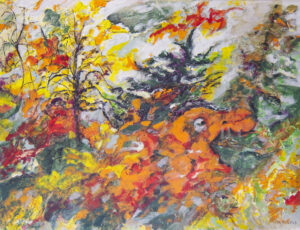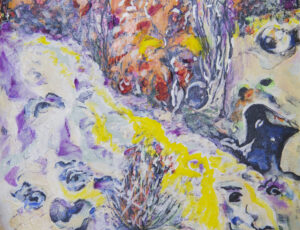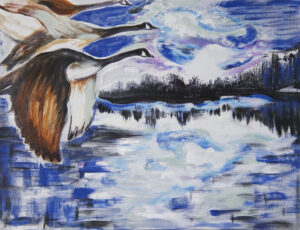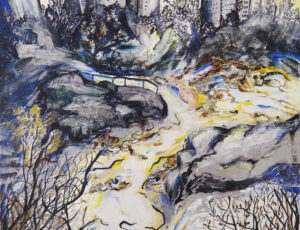Nataliia Kononova: Mysteries near the Waterfall
Carleton University – Maxwell MacOdrum Library
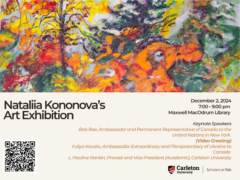
Exhibition Dates: November 29th to December 31st 2024
Vernissage: Monday December 2nd, 2024, 7:00 to 9:00 PM
Refreshments provided
Dates de l’exposition: Du 29 novembre au 31 décembre 2024
Vernissage: Le lundi, 2 décembre, 2024, de 19h à 21h
Des boissons sont offertes
With your financial support, Carleton University will emerge as a global leader in the fight for academic freedom and human rights. Support Scholars at Risk by funding our efforts to provide a safe environment within our institution for scholars whose lives are threatened due to the nature of their academic works.
Carleton employees can donate through monthly payroll deduction: a simple and secure way to have a great impact. Simply select this as your preferred method of payment on FutureFunder.ca.
Nataliia’s Artist Statement
I have grown to believe that the human being is a vessel from which flows that which has filled it. This has been especially true of my creative work because art has always been my passion. My journey into art began a long time ago and it continues today. During the past forty years, I have used my work as a journalist as an experimental field for the search of forms and meanings of the beautiful, the monstrous, the high and the low, the majestic and the vulgar.
My journalistic career began as a correspondent for large-circulation factory newspapers. The goal was to find within the routines and facts of factory life means of improving that life. To achieve this, I had to delve into the economic, political, cultural, and ideological problems related to this subject.
By 1998, I became a correspondent for the first big private national newspaper—Kievskie vedomosti—which was published three times a day in several languages. I became the newspaper’s only representative in the difficult mining region of Donbas in eastern Ukraine, where I had to “dig” deep in search of the relevant and this led to my meeting of interesting, talented people. These people were often artists, inventors, sculptors, writers, civil servants, and politicians. As I went to work for other publications, I continued to grow, change, and search for new forms, designs, and images. I was helped in this search by my synesthesia, the sensory phenomenon of seeing letters and words in colour.
When war began in 2014 in Ukraine, my husband and I were forced to move temporarily to Galicia in the west of Ukraine, where my husband continued to pursue his academic studies. Galicia is a wonderful, beautiful part of Ukraine. Its mountains, rivers, valleys, flora and fauna can be admired endlessly. It’s impossible not to paint there.
In the Galician city of Ivano-Frankivsk, I began working with ceramics, which local craftsmen have always practiced here. By accident, I came upon my own style of creating paintings by layering fabrics. After all, one can paint not only with paints, but also with clay, fabrics, wood, or stone. The principle that I have always tried to follow has to do with “dynamism,” by which an image attains a maximum of movement. As long as there is such “dynamism” in a picture, there is life. In 2018, my first exhibit of fabric paintings took place at the gallery “Bastion” in Ivano-Frankivsk, under the title “Shores”.
Seven years after the start of the war, we returned home to Donbas. We purchased a house in Bakhmut, where we moved all of our belongings, including all the paintings and ceramics that I had completed in the last seven years. Four months later, the war took away both our home and my art collection.
Under the auspices of the international organization “Scholars at Risk,” our new friends at Carleton University—Milana Nikolko, Dana Dragunoiu, Andrew Wallace, Norah Vollmer, Angelo Mingarelli, Alex MacLellan, and Brian Foss—provided us with a new life, this time in Ottawa. Ottawa provided other friends, too, such as Tanya Chour and the Botygin family.
Though we continue to have one foot in Ukraine next to our children, we live a full life filled with creativity in Ottawa. My husband is pursuing his scholarly studies while I work with acrylics. We live next to a park near the Hog’s Back waterfall. It is impossible to get enough of its beauty: every day is different, unexpected, unlike the previous day. Thousands of years can be seen through its fast waters. In its expansive flows, I see human faces, the contours of marvelous animals and fantastic creatures.
_____________________________________________
About the Artist
Nataliia Kononova is a Ukrainian journalist from Donbas. By 1998, she became a correspondent for the first major private national newspaper, Kievskie vedomosti. While reporting about the mining region of Luhansk and Donetsk, she often wrote about artists, inventors, sculptors, writers, civil servants, and politicians.
When war began in Ukraine in 2014, she and her husband moved temporarily to Ivano-Frankivsk, where her husband continued his work as a professor and researcher. Here, while continuing to work as a journalist, she also took up working in ceramics. In doing so, she accidentally found her own style of creating paintings by layering fabrics. The main principle that informs her work is “to achieve the ‘dynamism’ of an image for the sake of maximum emotionality.” In 2018, the Ivano-Frankivsk gallery Bastion hosted her first exhibition of fabric paintings. Seven years after the start of the war, she and her husband returned to Donbas, but four months later, the war destroyed their new home as well as Nataliia’s collection of paintings and ceramics.
The Carleton University chapter of the international organization Scholars at Risk gave her husband the opportunity to continue pursuing his academic work in Ottawa and Nataliia the opportunity to paint again. Nataliia says: “A person is like a vessel from which flows that which has filled it. We live in Ottawa near the Hog’s Back waterfall, which is different and unexpected every day of the year. Thousands of years can be seen through its fast waters. In its expansive flows, I see human faces, the contours of marvelous animals and fantastic creatures.”
For more information about the artist, please visit our website at: https://carleton.ca/scholars-at-risk/
Наталія Кононова – українська журналістка, яка народилася та працювала на Донбасі, до 1998 року доросла до власного кореспондента першої великої приватної національної газети «Київські відомості», яка виходила тричі на день кількома мовами. Вона стала представником цієї газети у важкому шахтарському регіоні в Луганську та Донецьку, у пошуках актуальної інформації часто писала про художників, винахідників, скульпторів, письменників, чиновників, політиків.Коли в Україні у 2014 році розпочалася війна, із чоловіком вона тимчасово переїхала на Захід України до Івано-Франківська, де її чоловік продовжив свою дослідницьку роботу. В Івано-Франківську, крім журналістики, зайнялася керамікою, якою тут завжди славилися місцеві майстри, випадково знайшла свій стиль тканинних картин, що створювала методом нашарування. Зрозуміла, що малювати можна не лише фарбами – а й глиною, тканинами, деревом, каменем…. Головний принцип, яким завжди прагнула слідувати – це «домагатися “летючості” зображення, динаміки та максимальної емоційності». 2018 року в Івано-Франківській галереї “Бастіон” відбулася її перша виставка тканинних картин під назвою “Береги”.
Через 7 років після початку війни вони повернулися на Донбас, але за 4 місяці війна знову забрала і будинок, і колекцію картин з керамікою.Міжнародний проект “Scholars of Risk” (Вчені в небезпеці), нові друзі – викладачі Карлтонського університету в Оттаві (Канада) дали можливість їй знову працювати і створювати картини, а чоловікові – займатися наукою. Наталія каже: «Людина, як судина, з неї виливається те, чим вона наповнена. Ось мої картини. Ми живемо в Оттаві біля водоспаду Hog’s Back, яким неможливо пересититися – він щодня інший, несподіваний, не схожий на себе вчора. Крізь його швидкі води проглядаються тисячоліття, а у космах сивих вод я бачу людські обличчя, контури дивовижних тварин та фантастичних істот».
Nataliia Kononova est une journaliste ukrainienne, originaire de la région du Donbas. En 1998, elle devient correspondante avec le premier grand journal national privé, Kievskie vedomosti. Les reportages qu’elle faisait dans les régions minières de Luhansk et Donetsk lui ont donné l’occasion d’écrire des articles à propos d’artistes, d’innovateurs, d’écrivains, de fonctionnaires et de politiciens .
Au début de la guerre en Ukraine en 2014, elle a dû fuir sa région temporairement avec son mari et ils sont restés dans la région d’Ivano-Frankivsk, où son mari a pu poursuivre ses travaux académiques. Pendant cette période en exil, en plus de son travail de journaliste , elle commence à explorer la céramique. Dans le cadre de ce nouveau projet, Nataliia découvre son propre style unique en créant des peintures auxquelles elle ajoute des couches de tissu. Le principe fondateur qui guide son travail est «d’établir le ‘dynamisme’ de l’image dans le but de créer une réaction émotive maximale ». En 2018, la galerie Bastion en Ivano-Frankivsk tient sa première exposition de peintures à base de tissu, qui s’intitule «Rivages». Sept ans après le début de la guerre, elle rentre au Donbas avec son mari. Cependant, à peine quatre mois après leur retour, leur maison, et son ensemble d’œuvres, sont détruits en raison de la guerre.
Le mari de Nataliia reçoit une offre qui lui permettrait de poursuivre son travail académique (en sécurité??) par l’organisation «Scholars at Risk» avec le soutien de son chapitre à l’Université Carleton à Ottawa, au Canada. Ceci a également permis à Nataliia de reprendre sa pratique artistique dans la capitale canadienne. Dans les mots de Nataliia: «L’individu est un vaisseau qui s’écoule en suivant tout ce qui le remplit. Nous vivons à Ottawa, à quelques pas des Chutes Hog’s Back, qui changent de façons inattendues tous les jours de l’année. Des milliers d’années peuvent être aperçues dans ses eaux rapides. Je vois des visages humains et les contours d’animaux fantastiques dans ses gigantesques courants.
Pour en savoir plus sur l’artiste, veuillez cliquer sur lien suivant www.carleton.ca/scholars-at-risk.
_________________________________________________________________________________
About Scholars at Risk Carleton (SAR Carleton)
To commemorate the 76th anniversary of the Universal Declaration of Human Rights, we are excited to have this opportunity to highlight the crucial role that Carleton University’s Scholars at Risk (SAR) program, along with SAR programs across Canada, play in strengthening Canada’s commitment to human rights and academic freedom.
Since 2014, Carleton’s Scholars at Risk program has provided a safe haven to 20 at-risk scholars facing threats to their scholarship and lives. In turn, these scholars enrich Carleton’s academic environment by integrating diverse perspectives and establishing new connections in scholarship and research.
You can learn more about our program at www.carleton.ca/scholars-at-risk. If you would like to support our program, please visit our FutureFunder site at https://carleton.ca/scholars-at-risk/donate/.
À l’occasion du 76e anniversaire de la Déclaration universelle des droits de la personne, nous sommes ravis de pouvoir souligner le rôle important que joue le programme Scholars at Risk (SAR) de l’Université Carleton, comme d’autres programmes SAR à travers le Canada, dans la protection et la promotion des droits humains et de la liberté académique.
Depuis 2014, le programme Scholars at Risk de Carleton a fourni un espace sécuritaire à 20 universitaires menacés pour leurs idées et dont la liberté académique, voire leur vie, sont en danger. En intégrant une diversité de perspectives et en établissant de nouvelles connexions académiques à notre institution, ces universitaires enrichissent à leur tour l’environnement académique de Carleton.
Pour en savoir plus sur ce programme, veuillez cliquer sur lien suivant www.carleton.ca/scholars-at-risk. Si vous aimeriez soutenir ce programme, visitez notre site FutureFunder à travers ce lien https://carleton.ca/scholars-at-risk/donate/.
_________________________________________________________________________________
About the Curator
Leo Khordoc-Davis, the curator of this exhibit, is a young artist who is currently studying fine arts at Concordia University. He was born and raised in Ottawa and discovered a passion for painting when he spent a year living in France with his parents when he was twelve years of age. He has exhibited his work several times at outdoor festivals and in art galleries.
Léo Khordoc-Davis, qui est le conservateur de cette exposition, est un jeune artiste qui fait présentement ses études dans le programme de beaux-arts à l’Université Concordia. Il a grandi à Ottawa et il a découvert sa passion pour la peinture à l’âge de douze ans lors d’une année sabbatique passée en France avec ses parents. Il a exposé son travail plusieurs fois dans des festivals à l’extérieur ainsi que dans des galeries d’art.
_________________________________________________________________________________
Design and layout services provided by the School for Studies in Art and Culture
